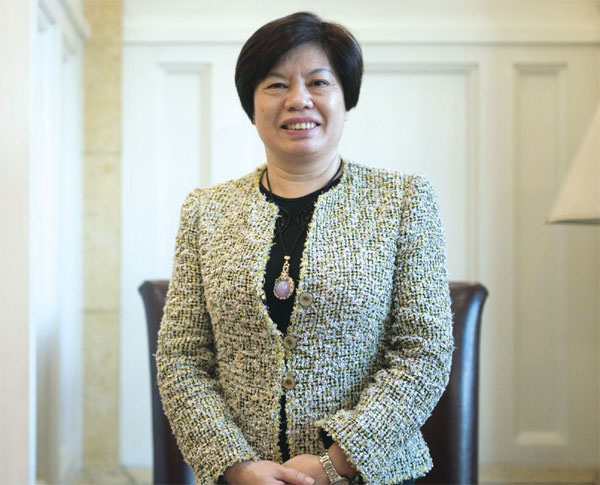The road to greener pastures
Updated: 2017-03-16 07:35
By Luo Weiteng(HK Edition)
|
|||||||
HK manufacturers told to come on as Belt and Road Initiative revs up
With the drawn-out "winter" showing no signs of letting up, many of Hong Kong's hard-pressed manufacturers, who are among the worst hit in the protracted economic slump, have had to bite the bullet, and are leaving no stone unturned in looking for the panacea to ride out the storm and recreating the heyday of yesteryear.
They are left with few choices - either to diversify, continue innovating as an awful lot have done so, or scour far beyond for greener pastures to keep their heads above the water and to avert being forced to the wall.
Pauline Ngan Po-ling - a Hong Kong deputy to the National People's Congress (NPC) who helms Mainland Headwear, the largest headwear manufacturer in Guangdong province - had gone the extra mile. Her strategy was calculated and swift.
|
Pauline Ngan Po-ling, a Hong Kong deputy to the National People's Congress who helms Mainland Headwear, uses her own operating experience to urge Hong Kong's hard-pressed manufacturers to join in the nation's Belt and Road Initiative. Provided to China Daily |
Back in 2013 when she made up her mind to move part of her operations in Shenzhen to Bangladesh - now billed as one of South Asia's finest "jewels" - her enterprise was tottering on the brink of bankruptcy as labor and production costs escalated.
Some four years on, Ngan, who was the company's managing director, can now possibly breathe a sigh of relief.
She has not only recouped her investment in the South Asian nation, but has got a production plant up and about on the outskirts of the capital, Dhaka, manned by some 3,500 locals.
"I'm proud to say I had made such a bold move, winning me a business opportunity for at least another 20 years," Ngan told China Daily in Beijing.
"I was also fortunate to have been the only one among five Hong Kong headwear makers in Guangdong to have survived. If I had hesitated, we would have certainly bit the dust."
The strategic, China-led Belt and Road (B&R) Initiative and the prospects it promises to hold for the future has been instrumental in Ngan's business foresight, courage and determination to take the plunge in Bangladesh, where it would take no less than 14 hours to commute between Dhaka and the key port of Chittagong in the south-eastern part of the country, and with crippling power outages being commonplace, sometimes occurring up to 30 times a day.
The much heralded trade and infrastructure initiative, first mooted by President Xi Jinping in 2013 - the year when Ngan set foot in Bangladesh - aims to build up an expansive interconnected network of roads and railways linking land and sea ports, special economic zones, industrial corridors and transportation hubs from the coasts of China to the Middle East and Europe.
Built with Chinese technical and financial aid, new highways have drastically reduced the time it would take to transport products to Chittagong by nearly 60 percent to less than six hours. The driving time between Dhaka's Shahjalal International Airport and Ngan's factory has also been cut from two hours previously to no more than an hour.
Last year, energy-starved Bangladesh secured a $165- million loan from the China-led Asian Infrastructure Investment Bank to upgrade and expand the country's power distribution system, ensuring uninterrupted electricity supply to every single village by 2020.
"As one of the pioneers and being among the first batch of beneficiaries of the B&R push, it's this landmark project that prompted me to wade into such an unfamiliar market without any hesitation, and has given my company a new lease of life," said Ngan.
"I firmly believe the B&R Initiative is something struggling manufacturers in Hong Kong and on the Chinese mainland could place their hope in to help them come out of the woods."
The hardships plaguing manufacturers in the world's second-largest economy have widened from mere acute labor shortages to skyrocketing labor costs, highlighting the urgency for companies to move their labor-intensive operations out of the mainland and climb up the value chain.
But, this can be a daunting task, with about 70 percent of Hong Kong manufacturers in the Pearl River Delta failing to emerge from the "chilly industry-wide winter".
"As for now, I've no idea when this long 'winter' will come to an end," moaned Ngan. "This underscores the reality that we just cannot afford to miss the B&R fast train to help us pull through."
Relocating labor-intensive businesses to cheaper production bases abroad, however, does not make up the full picture of manufacturers going out.
"Greater focus should be placed on encouraging and boosting innovation, nurturing the spirit of craftsmanship and polishing up our home brands," Ngan said. "This also fits in well with what the central government has been clamoring for."
With more than 60 percent of Mainland Headwear's operations shifted to Bangladesh, where wages are just one-tenth of those in Shenzhen, the pool of workers left behind at Ngan's Shenzhen unit has been halved - from its peak of 4,000 to 2,000. They include 1,400 who're engaged in research and development, while the rest are in charge of production, with high value added and catering to the ever-changing tastes of the high-end US and European markets.
sophia@chinadailyhk.com
(HK Edition 03/16/2017 page5)
